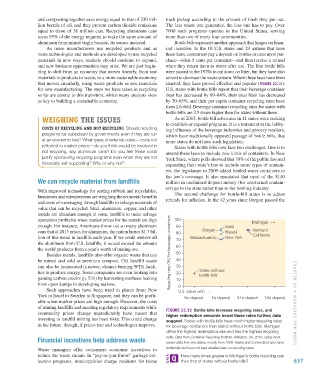Page 638 - Environment: The Science Behind the Stories
P. 638
and composting together save energy equal to that of 230 mil- trash pickup according to the amount of trash they put out.
lion barrels of oil, and they prevent carbon dioxide emissions The less waste one generates, the less one has to pay. Over
equal to those of 36 million cars. Recycling aluminum cans 7000 such programs operate in the United States, serving
saves 95% of the energy required to make the same amount of more than one of every four communities.
aluminum from mined virgin bauxite, its source material. Bottle bills represent another approach that hinges on finan-
As more manufacturers use recycled products and as cial incentive. In the 10 U.S. states and 23 nations that have
more technologies and methods are developed to use recycled these laws, consumers pay a deposit on bottles or cans upon pur-
materials in new ways, markets should continue to expand, chase—often 5 cents per container—and then receive a refund
and new business opportunities may arise. We are just begin- when they return them to stores after use. The first bottle bills
ning to shift from an economy that moves linearly, from raw were passed in the 1970s to cut down on litter, but they have also
materials to products to waste, to a more sustainable economy served to decrease the waste stream. Where these laws have been
that moves circularly, using waste products as raw materials enacted, they have proved effective and popular (FIGURE 22.12).
for new manufacturing. The steps we have taken in recycling U.S. states with bottle bills report that their beverage container
so far are central to this transition, which many analysts view litter has decreased by 69–84%, their total litter has decreased
as key to building a sustainable economy. by 30–65%, and their per capita container recycling rates have
risen 2.6-fold. Beverage container recycling rates for states with
bottle bills are 2.5 times higher than for states without them.
WEIGHING THE ISSUES As of 2013, bottle bill advocates in 11 states were seeking
to establish or expand programs. It is a testament to the lobby-
COSTS OF RECYCLING AND NOT RECYCLING Should recycling ing influence of the beverage industries and grocery retailers,
programs be subsidized by governments even if they are run which have traditionally opposed passage of bottle bills, that
at an economic loss? What types of external costs—costs not more states do not have such legislation.
reflected in market prices—do you think would be involved in States with bottle bills now face two challenges. One is to
not recycling, say, aluminum cans? Do you feel these costs amend these laws to include new kinds of containers. In New
justify sponsoring recycling programs even when they are not York State, where polls showed that 70% of the public favored
financially self-supporting? Why or why not? expanding their state’s law to include more types of contain-
ers, the legislature in 2009 added bottled water containers to
the law’s coverage. It also mandated that most of the $140
We can recycle material from landfills million in unclaimed deposit money (for unreturned contain-
ers) go to the state rather than to the bottling industry.
With improved technology for sorting rubbish and recyclables,
businesses and entrepreneurs are weighing the economic benefits The second challenge for bottle-bill states is to adjust
and costs of rummaging through landfills to salvage materials of refunds for inflation. In the 42 years since Oregon passed the
value that can be recycled. Steel, aluminum, copper, and other
metals are abundant enough in some landfills to make salvage
operations profitable when market prices for the metals are high 100 Michigan
enough. For instance, Americans throw out so many aluminum 90 Iowa
cans that at 2013 prices for aluminum, the nation buries $1.7 bil- 80 Oregon Hawaii Vermont
lion of this metal in landfills each year. If we could retrieve all 70 Massachusetts New York California
the aluminum from U.S. landfills, it would exceed the amount
the world produces from a year’s worth of mining ore. 60
Besides metals, landfills also offer organic waste that can Recycling rate (%) for beverage containers 50
be mined and sold as premium compost. Old landfill waste 40
can also be incinerated in newer, cleaner-burning WTE facili- 30
ties to produce energy. Some companies are even looking into 20 States without
gaining carbon credits (p. 531) by harvesting methane leaking 10 bottle bills
from open dumps in developing nations. 0
Such approaches have been tried in places from New U.S. states with . . .
York to Israel to Sweden to Singapore, and they can be profit- No deposit 5¢ deposit 5+¢ deposit 10¢ deposit
able when market prices are high enough. However, the costs CHAPTER 22 • MAN A GING OUR WASTE
of mining landfills and meeting regulatory requirements while FIGURE 22.12 Bottle bills increase recycling rates, and
commodity prices change unpredictably have meant that higher redemption amounts boost these rates further, data
investing in landfill mining has been risky. This could change suggest. States with bottle bills have much higher recycling rates
in the future, though, if prices rise and technologies improve. for beverage containers than states without bottle bills. Michigan
offers the highest redemption rate and has the highest recycling
Financial incentives help address waste rate. Data from Container Recycling Institute, Arlington, VA, 2010, using most
recent data from the states, mostly from 2009. Maine and Connecticut also have
Waste managers offer consumers economic incentives to bottle bills but have not kept detailed data on recycling rates.
reduce the waste stream. In “pay-as-you-throw” garbage col- How many times greater is Michigan’s bottle recycling rate
lection programs, municipalities charge residents for home than that of states without bottle bills? 637
M22_WITH7428_05_SE_C22.indd 637 13/12/14 2:25 PM

